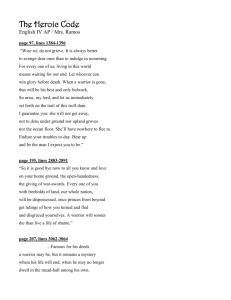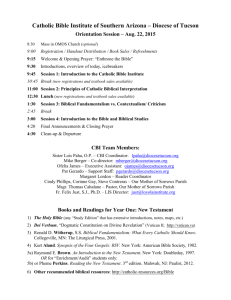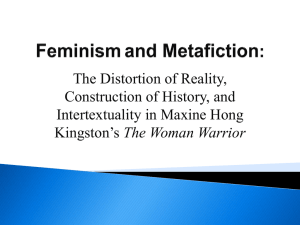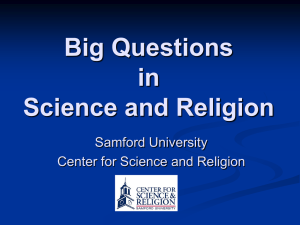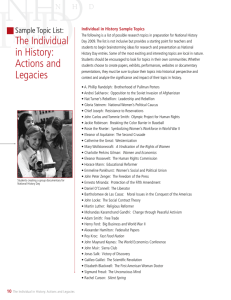Journal of Religion & Society
advertisement
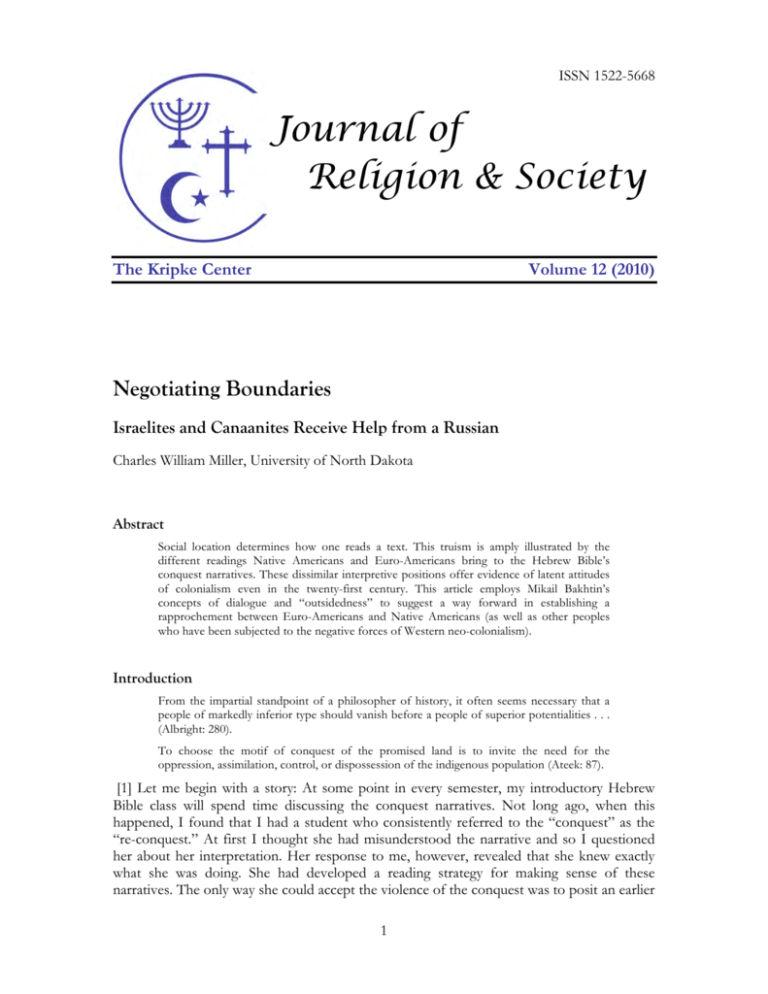
ISSN 1522-5668 Journal of Religion & Society The Kripke Center Volume 12 (2010) Negotiating Boundaries Israelites and Canaanites Receive Help from a Russian Charles William Miller, University of North Dakota Abstract Social location determines how one reads a text. This truism is amply illustrated by the different readings Native Americans and Euro-Americans bring to the Hebrew Bible’s conquest narratives. These dissimilar interpretive positions offer evidence of latent attitudes of colonialism even in the twenty-first century. This article employs Mikail Bakhtin’s concepts of dialogue and “outsidedness” to suggest a way forward in establishing a rapprochement between Euro-Americans and Native Americans (as well as other peoples who have been subjected to the negative forces of Western neo-colonialism). Introduction From the impartial standpoint of a philosopher of history, it often seems necessary that a people of markedly inferior type should vanish before a people of superior potentialities . . . (Albright: 280). To choose the motif of conquest of the promised land is to invite the need for the oppression, assimilation, control, or dispossession of the indigenous population (Ateek: 87). [1] Let me begin with a story: At some point in every semester, my introductory Hebrew Bible class will spend time discussing the conquest narratives. Not long ago, when this happened, I found that I had a student who consistently referred to the “conquest” as the “re-conquest.” At first I thought she had misunderstood the narrative and so I questioned her about her interpretation. Her response to me, however, revealed that she knew exactly what she was doing. She had developed a reading strategy for making sense of these narratives. The only way she could accept the violence of the conquest was to posit an earlier 1 Negotiating Boundaries violence against the Israelites, which violence resulted in the loss of “their” land. They subsequently acted in “self-defense” and reclaimed the land that actually belonged to them. For her, it was a “re-conquest.” Although her reading was not entirely appropriate to the text, at least, it was the result of a clear recognition of the ethical and theological problems posed by these stories: What manner of God would order the complete annihilation of every living being, including innocent babies, so that a people could possess a land that was not theirs? What sort of people, moreover, would carry out those orders with such zeal and without even a single protest? What would it be like to be the victim of that violence, rather than its beneficiary? These questions were both significantly troubling and sufficiently important for my student to force her to develop a reading strategy that would “solve” the problem. [2] It is actually very rare for any of my students to respond to the conquest stories in this way. I have often wondered why so few of my students recognize the narratives as problematic. In fact, after sitting through numerous sermons glorifying, for example, the fall of Jericho, I have often wondered why so few Americans, in general, are troubled by these stories? The answer, more than likely, is that most of us read like “Israelites” – that is to say, we read these texts from the perspective of the conqueror. But why should we “automatically” read these stories in this manner? There are several reasons for doing this, not the least of which is the fact that this is the perspective of the narrator and the average person is not taught to read “against the grain” of a text’s ideology. I believe that there is another significant reason, as well, but we will delay that discussion until later. At this point, however, it would be good to examine the work of someone who recognized the problematic nature of the conquest narratives and who chose not to read them as an “Israelite” would, but, instead, to read those stories like a “Canaanite” – from the perspective of the conquered. Cowboys, Indians, and Canaanites [3] In 1989, Robert Allen Warrior wrote a highly influential and widely anthologized article entitled, “Canaanites, Cowboys, and Indians: Deliverance, Conquest, and Liberation Theology Today” (reprinted in a 1995 anthology, which is cited here). Warrior argued against the development of a Native American liberation theology primarily because “[m]ost of the liberation theologies that have emerged in the last twenty years are preoccupied with the Exodus story, using it as the fundamental model for liberation” and “the Exodus story is an inappropriate way for Native Americans to think about liberation” (278). The concern, for Warrior, is not the Exodus story per se, since he recognizes the fact that many people around the world have seen the “god who takes the side of the oppressed and powerless” as “a beacon of hope.” The problem is what follows that liberating event: [T]he liberationist picture of Yahweh is not complete. A delivered people is not a free people, nor is it a nation. People who have survived the nightmare of subjugation dream of escape. Once the victims have been delivered, they seek a new dream, a new goal, usually a place of safety away from the oppressors, a place that can be defended against future subjugation. Israel’s new dream became the land of Canaan . . . Th[is] land, Yahweh decided, belonged to these former slaves from Egypt and Yahweh planned on giving Journal of Religion & Society 2 12 (2010) Negotiating Boundaries it to them – using the same power used against the enslaving Egyptians to defeat the indigenous inhabitants of Canaan. Yahweh the deliverer became Yahweh the conqueror (279). It is the conquest, not the exodus, that is the problem for Warrior, especially “those parts of the story that describe Yahweh’s command to mercilessly annihilate the indigenous population” (279). Native Americans, according to Warrior, will identify with the Canaanites (the conquered), not the Israelites (the conqueror). In other words, Warrior (like most Native Americans) reads these narratives like a “Canaanite” (cf. Weaver 1993: 40; Baldridge: 100-101). [4] Warrior’s sensitivity to this issue is obviously grounded in his social location (see, as well, Ateek; Fernandez). He is a Native American, a member of the Osage Nation. The history of the First Nations in this land is one of conquest by outsiders and attempted genocide. As Warrior reminds us, “[m]any Puritan preachers were fond of referring to Native Americans as Amalekites and Canaanites – in other words, people who, if they would not be converted, were worthy of annihilation” (283). Alfred Cave shows that it was not just the Puritans but other religious groups as well who thought of the indigenous population of the Americas as Canaanites. Cave cites Sir George Peckham, “a prominent Catholic nobleman,” who wrote that the English had the same claim to the New World as did the Israelites to Canaan. Those Native Americans who resisted “God’s new chosen people” were to be exterminated and those who submitted were to be enslaved (234; see Kadir). The indigenous peoples of this country have lived out, in their history, the same fate as the indigenous peoples of ancient Canaan. Warrior (and other Native Americans) reads like a Canaanite, because, in many ways, he is a Canaanite. Full Disclosure [5] Now seems like an appropriate time to say something about my own background and context, for if Warrior’s reading of the exodus and conquest narratives are influenced by his social location (and it is obvious they are), then it is equally probable that my own background will influence my readings (see Tolbert 1995a, 1995b). For, surely, if there is anything postmodernism and postcolonialism have taught us, it is to be suspicious of claims to an objective perspective or assertions of disinterested conduct. All viewpoints must be decentered and all actions problematized. Perspective and act originate in a specific historical and ideological context. That is as true of articles we write (or read), as it is of the scriptures we read (or write?). My context is important to the way I read and understand the biblical texts that address the exodus and the conquest, as well as how I respond to Warrior’s article, which seeks to interpret those texts. [6] I am a white, Euro-American male, heterosexual and married, who lives in the United States and who holds a tenured position at a public university. That description (along with other unmentioned, but equally significant descriptors) reveals that I occupy several positions of privilege, both in relationship to most people around the world and in relation to many within the United States. Almost none of these privileged positions stem from personal accomplishment, but are based, rather, on an accident of birth, as well as on a domination system that has predetermined that some subject positions will always be dominant, whereas others will always remain marginalized. I must admit that I would like to Journal of Religion & Society 3 12 (2010) Negotiating Boundaries believe that, at least, my tenured academic position is based solely on my personal accomplishments, which are grounded in my mastery of the necessary skills, as well as my own hard work. I must recognize, however, that even these “accomplishments” may have been made possible primarily because one or more of my privileged positions (gender, class, race, and so forth) provided me with opportunities others may not have had. [7] Unlike Warrior, moreover, my ancestors were not native to this land, but came to it as aliens and strangers, claiming it as their own. I am not personally aware of any of my forebears who fought and killed Native Americans, but I would not be surprised to learn that this was the case, for both sides of my family came to live in America long before the wars between the indigenous peoples of this land and the newly arrived Europeans had ended. Regardless of whether or not my ancestors actively participated in the genocide, they would surely have supported the forced removal of Native Americans from their lands and, thereby, sanctioned the violence that often accompanied that removal. It is also likely that, when they went to church on Sunday mornings, they would have heard sermons about the American “Canaanites” and would have seriously considered the appeals of missionaries, who were intent on “Christianizing” the “heathens and savages” and, thereby, would probably have aided and abetted the church’s continued attempts at cultural genocide (Tinker 1993; Noley; Deloria; Weaver 1993). [8] There is one further bit of background information about myself that should be included. I presently find myself teaching at a university that prides itself on its educational programs for Native Americans. The school has over twenty different programs now and is considering expanding these as well as initiating even more programs. Everyone applauds these efforts and believes that they should be continued. There is, however, an element of irony in all of this. The sports teams at the university are known as the “Fighting Sioux” and they use an Indian head logo – fleshed out with long hair, feathers, and “war” paint. All of the tribal councils that are historically associated with the Sioux – as well as most of the other First Nations groups scattered throughout the three state area – have asked the university to discontinue the use of this name and of this logo. They strongly argue that the usage of the name and logo shows disrespect to First Nations people and to their culture. They also believe it creates a hostile environment for the American Indian students who attend the university – an opinion shared and communicated to the university by the National Collegiate Athletic Association and the Higher Learning Commission of the North Central Association of Colleges and Schools. Until very recently, the State Board of Higher Education and the administration of the university refused to listen and stated that they did not intend to change the name or the logo. At the root of the problem is an alumnus (who died a few years ago) and his gift to the university of a hockey arena that cost over one hundred million dollars to build. He liked the name and the logo. He believed the university should keep them regardless of what the Native Americans think. In fact, he and the other supporters of the name and logo have claimed that the use of name and logo do indeed honor Native Americans. The implication is that the Native Americans do not know what is good for them, but other people do. In North Dakota, where I teach, colonialism (both as a reality and as an attitude) continues to thrive and it is this background that also provides one of the contexts for my own reading of these texts. Journal of Religion & Society 4 12 (2010) Negotiating Boundaries [9] If Warrior’s social location allows him to read like a Canaanite, what does my social location reveal about the way I read the exodus and conquest texts? How might my background explain why I, like so many other Americans, read like an Israelite? The reason seems apparent: I (and many other Americans) read like an Israelite, because I am, in many ways, an Israelite.1 [10] My present positions of privilege are grounded in a domination system that allowed and actively pursued the conquest, subjugation, and annihilation of the indigenous peoples of this land. My reading of the conquest stories, as an Israelite, is not only a “natural” reading, at least in part because of my connection to those who took this land from its original inhabitants, but it is also a reading strategy that serves to protect me from those difficult questions I might otherwise bring to the biblical conquest stories – questions that would then become relevant to the American conquest story, to my own story. What, then, is an Israelite to do? Three Possible Responses [11] Warrior suggests three possibilities for action, although I will only address his first two. The third seems primarily directed toward Native Americans and suggests that they would do better to look somewhere other than Christianity “for [their] vision of justice, peace, and political sanity . . . leaving the gods of this continent’s real strangers to do battle among themselves” (285; see Maluleke). For those who are not Native Americans, Warrior has two suggestions. The first course of action is that “the Canaanites should be at the center of Christian theological reflection and action” (283). I take this as primarily a call, both to scholars of religion and to persons of faith, to recognize and take seriously the ways in which the Bible is as much a text of imperialism, as it is one of liberation. Postcolonial critics often emphasize this ambiguity in the Bible and charge biblical interpreters “to make this ambivalence visible and clear and to demonstrate that the Bible is part of the conundrum rather than a panacea for all the ills of a postmodern world” (Sugirtharajah 2002: 119). One of the ways for biblical scholars to do this is to bring into the center, from the margins, the voices of Native American biblical scholars and theologians, as well as others who have had similar experiences, especially those from the two-thirds world (Dube: 60). It is important for biblical scholars to hear and respond to the ways in which the Bible has been, and continues to be, interpreted to advance the cause of Euro-American colonial expansion. As Warrior states, “It is those who know these texts who must speak the truth about what they contain . . . It is those who act on the basis of these texts who must take responsibility for the terror and violence they can and have engendered” (283; see Sugirtharajah 1999: 5). [12] A second possibility for action, according to Warrior, is that “we need to be more aware of the way ideas such as those in the Conquest narrative have made their way into Americans’ consciousness and ideology” (283). Warrior is here speaking predominately of the political and theological writings that, in America’s history, have justified the conquest of the Americas and the genocide of the indigenous peoples. This is certainly something about 1 The connection I have made between the Israelites and myself is, of course, rhetorical and grounded in the literary world created in the “conquest” texts. It is not meant to indicate that my own contemporary context is in anyway commensurable with their ancient historical situation. Journal of Religion & Society 5 12 (2010) Negotiating Boundaries which most of us, who have benefitted and continue to benefit from these actions, do not know enough. One would want to add, however, that it would be equally important to learn about the ways this “conquest” ideology continues into the present day to shape our attitudes and policies toward Native Americans (both at the governmental level and within our respective church organizations). Furthermore, we will need to ask how this ideology has influenced and continues to impact our nation’s attitudes and policies toward other “Canaanites” – for example, Blacks in apartheid South Africa historically (Prior: 71-105) and Palestinians in Israel-Palestine presently (Ateek; Wagner). Mikail Bakhtin and Dialogue [13] At the heart of Warrior’s suggestions is a call to engage in a significant dialogue both with the history of the use of the Bible as a tool of oppression and imperialism in this country and with the values, traditions, and viewpoints of those whom the dominant system has marginalized and, in some cases, sought to destroy. But what would it mean for “Israelites” to engage in significant dialogue with “Canaanites”? Perhaps it is at this point we should turn to a Russian, Mikhail Bakhtin, and see what assistance he can offer to Israelites and Canaanites struggling with this problem. [14] To begin, it is important to note that, according to Katerina Clark and Michael Holquist, Bakhtin’s concept of dialogism is “founded on the ineluctability of our ignorance” (347). The recognition and admission of our ignorance about Native Americans and their lives (both historically and in our contemporary world) is a prerequisite for any meaningful dialogue. Warrior’s suggestions, as well, appear to address this issue and may be seen as a call for greater awareness and knowledge. The admission of one’s ignorance is not an easy thing to do, for, as Mary Ann Tolbert reminds us, “the denial of ignorance is an essential part of the ideology of dominance” (1995a: 350). For many of us, however, there has been no reason to deny our ignorance, because, in most cases, we were not aware of our ignorance. Steve Charleston offers the following illustration of this point: Now imagine that instead of groceries, this supermarket sells theologies . . . Dozens of different brands – a theology for every taste. There is a department for basic Western theologies, the old standbys. There are sections reserved for feminist theology, for Black theology, for liberation theology. There are shelves for African theology and Asian theology . . . At first glance, it seems that this supermarket has a Christian theology from every culture and community. Almost. But not quite. Something is missing . . . Go down the aisles and try to find the section for a Native People’s Christian theology. It isn’t there. Look for the department called Native American or American Indian Christian theology. Still not there . . . I doubt if Native People have been conspicuous by their absence . . . Not too many Christians seem troubled by the absence of a Native People’s Christian theology. I think if we are honest with one another, we will admit that most religious shoppers . . . never even noticed that Native People were missing (70; see also Kidwell, Noley, and Tinker). Most of us have not been aware of our ignorance about Native Americans because we had not “even noticed that Native People were missing” from our discussions. The first task is to Journal of Religion & Society 6 12 (2010) Negotiating Boundaries become aware of the extent of our ignorance and, then, and only then, will it be possible to do something about it. [15] Another prerequisite for dialogue, according to Bakhtin, is the recognition that dialogue cannot take place without, at least, two “independent and unmerged voices and consciousnesses” that view the world from distinct and unique viewpoints, thereby, offering each other a “surplus of vision” that serves to create a reality that is both richer and fuller than that which existed before. There can be no question that the viewpoints brought to a dialogue between Native Americans and Euro-Americans would be both unique and distinct. This would be the case even if we spoke only of each individual’s particular social location, as illustrated above. [16] George Tinker, however, has also identified three other differences between a EuroAmerican and a Native American approach to the Bible: “the theological function of the Old Testament within the Native American community, the sociopolitical context of the Native American peoples . . . [and] the discrete cultural particularities of cognitive structures . . . will necessarily generate ‘normatively divergent’ readings of Scripture” (1998: 174; see Weaver 1996: 153-76). By focusing only on the first of these examples identified by Tinker, we can illustrate significant differences between the approach taken by Native Americans and that taken by Euro-Americans. Native American Bible Interpretation [17] According to Tinker, the Old Testament, because of its strong narrative style, will be given more prominence than, say, the New Testament within many Native American Christian communities. However, the theological status of the Old Testament, relative to Euro-American congregations, may suffer. The reason for this is that “Native American Christians today would claim their own histories, cultural traditions, narratives, and traditional ceremonies as the appropriate traditional covenant (old testament) for their communities” (Tinker 1998: 174-75; see Charleston: 72-79). Furthermore, Tinker observes that the Old Testament “functions in two dysfunctional ways” for Native Americans. It “proscribes” traditional practices of the Native Americans and “prescribes” substituting Israelite history for the history of Native Americans (1998: 175). These differences are worthy of exploration and of dialogue, but only if Euro-Americans enter into a “real” dialogue with Native Americans. This “real” dialogue includes two significant factors that can be identified in Bakhtin’s description of monologue/monologism (obviously, the opposite of dialogue): Monologism, at its extreme, denies the existence outside itself of another consciousness with equal rights and equal responsibilities, another I with equal rights (thou). With a monologic approach (in its extreme or pure form) another person remains wholly and merely an object of consciousness, and not another consciousness. No response is expected from it that could change everything in the world of my consciousness. Monologue is finalized and deaf to the other’s response, does not expect it and does not acknowledge in it any decisive force . . . Monologue pretends to be the ultimate word (Bakhtin 1984: 292-93). Journal of Religion & Society 7 12 (2010) Negotiating Boundaries The two aspects of this quote I want to highlight are the equality of both participants – in terms of rights and responsibilities – and the fact that dialogue, unlike monologue, will result in a change of one’s own consciousness. For Euro-Americans and Native Americans to have a meaningful dialogue, Euro-Americans will need to learn to accept Native Americans as equal partners in the discussion. Euro-Americans have not shown, in the past, that they are able, or even willing, to do this. One does not need to go to missionary stories of the ancient past to discover how this is an understatement. One need only read and/or hear the testimonies of contemporary Native American Christians – both laypersons and ministers – to recognize the problem. D. A. Grinde, for example, begins his article with a brief anecdote from Rupert Costo, who was reflecting on an ironic event from his childhood in the early twentieth century: When the Christians took the Indian children off to boarding schools, the minister used to lead the children into the chapel and point up to the picture of Jesus, with long flowing hair, and tell the Indian children that they were going to learn how to be just like that man, Jesus. After this statement, the minister would send all the Indian boys off to get their hair cut short (124; see Archambault: 132-53). The other aspect of this issue is the unwillingness of Euro-Americans to change as a result of their dialogue with Native Americans. That is to say, Euro-Americans have always been much more interested in changing Native Americans than they have been in being changed by Native Americans. Perhaps another of Bakhtin’s concepts, outsidedness, will help us understand how this might be possible. Bakhtin and Outsidedness [18] Bakhtin’s notion of outsidedness is inherently bound to his idea of dialogue and is predicated on the notion of two unmerged consciousnesses, both of whom believe that they, as individuals, “cannot count and add up all of [them]selves, saying: this is all of me – there is nothing more anywhere else or in anything else; I already exist in full” (1990: 127). It is important to recognize, moreover, that outsidedness is a “relationship and an activity more than a place” (Clark and Holquist: 246). But of what does this “activity” or “relationship” consist? Bakhtin states: “The first step . . . is my projecting myself into him and experiencing his life from within him. I must experience – come to see and to know – what he experiences; I must put myself in his place and coincide with him, as it were . . . I must appropriate to myself the concrete life-horizon of this human being as he experiences it himself” (1990: 25). In terms of the Native American/Euro-American dialogue, this suggests that Euro-Americans must be willing to enter into the full experience of the Native American, as far as is possible – both historically and within the contemporary situation in which we now find ourselves. We must be willing to listen to the stories of how our interpretive practices have sanctioned, promoted, and justified – both in the past and in the present – policies and actions that have removed Native Americans from their lands, destroyed indigenous cultures, and caused unimaginable suffering and death. [19] I need to be clear, however, that this entering into the experience of the Native Americans is not meant to suggest that Euro-Americans can ever “become” Native Americans. I am not, in any way, giving support to the co-opting of Native American culture Journal of Religion & Society 8 12 (2010) Negotiating Boundaries by Euro-Americans. The enormous popularity of, for example, “Native American spirituality” and its commercialization by non-Native Americans is just another form of cultural genocide. There must be a recognition of boundaries (Bakhtin 1990: 126). [20] The “projecting” of the Euro-American into the experience of the Native American must be grounded in listening attentively and carefully to what the Native Americans have to say about their worldview, culture, history, and experience. In the end, we must return to ourselves, to our own place, “for only from this place can the material derived from my projecting myself into the other be rendered meaningful ethically . . . ” (Bakhtin, 1990: 26; emphasis added). The goal is to enlarge our view of the world with the other’s “surplus of vision” and, thereby, return to our own place in the world, so that we can examine critically that place we occupy – especially in terms of what it means to live as a privileged group within a larger global community. As Tolbert has stated, “the principal subject for reflection and analysis by First World scholars needs to be their own contexts and circumstances in light of the inequalities revealed in dialogue with those from the Two-Thirds World” (1995a: 356). [21] One would hope that by entering into a serious dialogue with Native Americans in this country, Euro-Americans would become more aware of the ways in which their interpretive practices have served and continue to serve the imperial designs of the Western world and, as that awareness increases, will begin to work more vigorously and more self-consciously to “decenter the hegemony of current Western neocolonialism” (Tolbert 1995a: 358) – both here in this country and around the world. Edward Said’s comments are both an appropriate challenge and a fitting conclusion: Modern imperialism was so global and all-encompassing that virtually nothing escaped it; besides . . . the nineteenth century contest over empire is still continuing today. Whether or not to look at the connections between cultural texts and imperialism is therefore to take a position in fact taken – either to study the connection in order to criticize it and think of alternatives for it, or not to study it in order to let it stand, unexamined and, presumably, unchanged (68). Bibliography Albright, W. F. 1957 From Stone Age to Christianity: Monotheism and the Historical Process. New York: Doubleday. Archambault, M. T. 1996 “Native Americans and Evangelization.” Pp. 132-53 in Native and Christian: Indigenous Voices on Religious Identity in the United States and Canada. Edited by J. Treat. New York: Routledge. Ateek, N. S. 1989 Justice and Only Justice: A Palestinian Theology of Liberation. Maryknoll: Orbis. Journal of Religion & Society 9 12 (2010) Negotiating Boundaries Bakhtin, Mikhail 1984 Problems of Dostoevsky’s Poetics. Theory and History of Literature 8. Edited and translated by C. Emerson. Minneapolis: University of Minnesota Press. 1990 “Author and Hero in Aesthetic Activity.” Pp. 4-256 in Art and Answerability: Early Philosophical Essays by M. M. Bakhtin. Edited by M. Holquist and V. Liapunov. Austin: University of Texas Press. Baldridge, William 1996 “Native American Theology: A Biblical Basis.” Pp. 100-101 in Native and Christian: Indigenous Voices on Religious Identity in the United States and Canada. Edited by J. Treat. New York: Routlege. Cave, Alfred 1988 “Canaanites in the Promised Land: The American Indian and the Providential Theory of Empire.” American Indian Quarterly 12, 1: 277-97. Charleston, Steve 1996 “The Old Testament of Native America.” Pp. 68-80 in Native and Christian: Indigenous Voices on Religious Identity in the United States and Canada. Edited by J. Treat. New York: Routledge. Clark, Katerina, and Michael Holquist 1984 Mikhail Bakhtin. Cambridge: Harvard University Press. Deloria, Vine 1999 For This Land: Writings on Religion in America. Edited by J. Treat. New York: Routledge. Dube, M. W. 2002 “Villagizing, Globalizing, and Biblical Studies.” Pp. 41-63 in Reading the Bible in the Global Village: Cape Town. Global Perspectives on Scholarship 3. Atlanta: Society of Biblical Literature. Fernandez, E. S. 2001 “Exodus-Towards-Egypt: Filipino-Americans’ Struggle to Realize the Promised Land in America.” Pp. 167-81 in A Dream Unfinished: Theological Reflections on America from the Margins. Edited by E. S. Fernandez and F. F. Segovia. Maryknoll: Orbis. Grinde, D. A. 1998 “Learning to Navigate in a Christian World.” Pp. 124-33 in Native American Religious Identity: Unforgotten Gods. Edited by J. Weaver. Maryknoll: Orbis. Journal of Religion & Society 10 12 (2010) Negotiating Boundaries Kadir, D. 1992 Columbus and the Ends of the Earth: Europe’s Prophetic Rhetoric as Conquering Ideology. Norman: University of Oklahoma Press. Kidwell, C. S., H. Noley, and G. E. Tinker. 2001 A Native American Theology. Maryknoll: Orbis. Maluleke, Tinyiko 2002 “What if We Are Mistaken about the Bible and Christianity in Africa?” Pp. 151-72 in Reading the Bible in the Global Village: Cape Town. Global Perspectives on Biblical Scholarship, 3. Atlanta: Society of Biblical Literature. Noley, H. 1991 First White Frost: Native Americans and United Methodism. Nashville: Abingdon. Prior, Michael 1997 The Bible and Colonialism: A Moral Critique. Biblical Seminar 48. Sheffield: Sheffield Academic Press. Said, Edward W. 1993 Culture and Imperialism. New York: Vintage/Random House. Sugirtharajah, R. S. 1999 “A Brief Memorandum on Postcolonialsim and Biblical Studies.” Journal for New Testament Studies 73: 3-5. 2002 Postcolonial Criticism and Biblical Interpretation. Oxford: Oxford University Press. Tinker, George E. 1993 Missionary Conquest: The Gospel and Native American Cultural Genocide. Minneapolis: Fortress. 1998 “Reading the Bible as Native Americans.” Pp. 153-76 in The Interpreter’s Bible, Volume 1. Edited by L. E. Keck. Nashville: Abingdon. Tolbert, M. A. 1995a “Reading for Liberation.” Pp. 263-76 in Reading from This Place, Volume 1: Social Location and Biblical Interpretation in the United States. Edited by F. F. Segovia and M. A. Tolbert. Minneapolis: Fortress. 1995b “Christianity, Imperialism, and the Decentering of Privilege.” Pp. 347-61 in Reading from This Place, Volume 2: Social Location and Biblical Interpretation in Global Perspective. Edited by F. F. Segovia and M. A. Tolbert. Minneapolis: Fortress. Journal of Religion & Society 11 12 (2010) Negotiating Boundaries Wagner, D. E. 2003 “Marching to Zion: The Evangelical-Jewish Alliance.” The Christian Century 120, 13: 20-24. Warrior, Robert Allen 1995 “Canaanites, Cowboys, and Indians: Deliverance, Conquest, and Liberation Theology Today.” Pp. 277-85 in Voices from the Margin: Interpreting the Bible in the Third World. Edited by R. S. Sugirtharajah. Maryknoll, New York/London: Orbis/SPCK. Weaver, Jace 1993 “Native Reformation in Indian Country: Forging a Relevant Spiritual Identity among Indian Christians.” Christianity and Crisis 53, 2: 39-41. 1996 “From I-Hermeneutics to We-Hermeneutics: Native Americans and the Post-Colonial.” Semeia 75: 153-76. Journal of Religion & Society 12 12 (2010)
